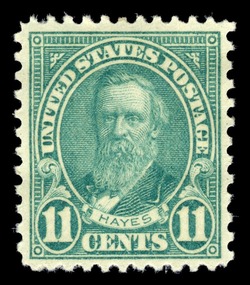
| Name | Value |
|---|---|
| Date of Issue | October 4, 1922 |
| Year | 1922 |
| Denomination |
11¢
|
| Denomination Value | $0.11 | Color | Light blue |
| Series | Ordinary Postage Stamps - Issue of 1922 |
| Series Time Span | 1925 |
| Issue Location | Washington, D.C., Fremont, Ohio |
| Size | 0.75 x 0.87 inches |
| Postal Administration | United States |

| Condition | Name | Avg Value |
|---|---|---|
|
M-NH-VF
|
Mint - Never Hinged - Very Fine | View price |
|
M-NH-F
|
Mint - Never Hinged - Fine | View price |
|
M-NH-VG
|
Mint - Never Hinged - Very Good | View price |
|
M-H-VF
|
Mint - Hinged - Very Fine | View price |
|
M-H-F
|
Mint - Hinged - Fine | View price |
|
M-H-VG
|
Mint - Hinged - Very Good | View price |
|
M-NG-VF
|
Mint - No Gum - Very Fine | View price |
|
M-NG-F
|
Mint - No Gum - Fine | View price |
|
M-NG-VG
|
Mint - No Gum - Very Good | View price |
|
U-VF
|
Used - Very Fine | View price |
|
U-F
|
Used - Fine | View price |
|
U-VG
|
Used - Very Good | View price |
Portrait of Hayes, from photograph, with the names "Hayes" on the ribbon below the portrait. The surrounding design is the same as the 2-cent stamp, with the necessary change of numerals representing the denomination. The stamp is printed in light blue ink. The 11-cent stamp was the first denomination of the new series issued. It was first placed on sale at Washington, D.C., and Fremont, Ohio, October 4, 1922, in connection with the celebration of the one hundredth anniversary of former President Hayes' birth.
This series of postage stamps was issued to replace the regular issue of stamps, known as the "Series of 1912."
There are 21 denominations in this series, each having a different subject as the central design and with larger numerals denoting the denominations.
The designs are most artistic and were selected with the view of giving historical and educational interest to the stamps.
Three different border designs were used for this series of stamps, which are the same size, 75/100 by 87/100 inch, as the 1912 issue.
The border design for the first 13 denominations (1-cent to 14-cent) is identical. A different border design was used for the 15-cent denomination and still another border design for the remaining seven denominations (20-cent, 25-cent, 30-cent, 50-cent, $1, $2, and $5).